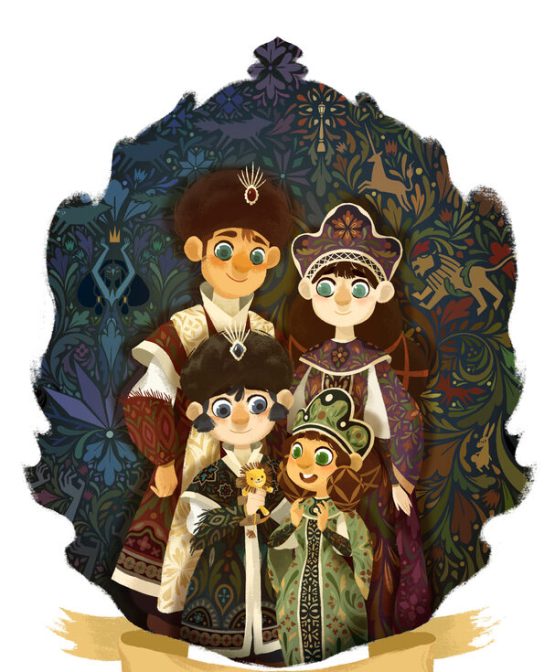
In looking up foreign editions of the Chronicles I came across some unique editions that were published in Russia and Ukraine. You can consider this post a companion to The Return of the White Witch: Russian Edition.
The three books above, The Lion, the Witch and the Wardrobe, The Horse and His Boy, and The Magician’s Nephew, came from a themed set. What’s interesting to me is that the cover artist clearly cribbed from Pauline Baynes’ pen-and-ink work, but added his or her own touches. Aslan in LWW looks like he has a white beard and goatee while the White Witch is as slinky as Baynes’ version, with her tall spiky crown. In the center pic, Bree is black and not the grayish dappled horse indicated in the text. And in the last, Strawberry, or Fledge rather, was a chestnut colored horse and not white — Baynes, who was very familiar with the text, colorized him so for special edition illustrations.
The common border the books share may be cribbed as well, though I’ve yet to find the original source. It incorporates a lion and unicorn at the top, nicely alluding to Narnia’s birth (through Aslan) and destruction (indicated by Jewel rearing in the flames) as well as the English nursery rhyme. The rest of the border includes Talking Mice, Telmarine soldiers, Eustace as a dragon, a faun, Cair Paravel, and a magic ring.
I am not 100% sure these covers were unique to Ukraine; as an artist and SEO detective, I have the nagging feeling I’ve seen them on some other editions. So much of the artwork is similar, if not incorporating Baynes’ original drawings it’s re-interpretations of them. But for the moment, I’ll say that they are.

A Russian edition of The Lion, the Witch, and the Wardrobe. The illustration is sweeter and more playful than the American depictions of the kids (though they do seem to be playing dress-up.) The little gnome or dwarf at the top left corner adds a touch of whimsy, which is a common thread throughout Slavic depictions.

Another Russian edition that deviates even more from the norm. This lavishly illustrated edition of LWW features illustrations by artist Maxim Mitrofanov, and right away we can tell we’re not in Kansas anymore (or WWII England, for that matter.) Just look at the snarled mop-tops on Edmond (with red hair and freckles) and Lucy. I can guess Edmond, as the problematic one of the four, is the one who got the “mischievous urchin” treatment. And oh how Russians love their mischievous urchins…!
The interior illustrations are pretty bizarre and take Narnia to whole other level. Like this one of the White Witch.

There are Hieronymous Bosch fairies flying around! Wearing boots and blowing horns! Those weren’t in the book. And the witch is reacting with some sort of disgust. I had originally posted this pic here, as a textbook example of a poorly conceptualized Jadis, but now that I’ve seen the artist’s other work I kind of… appreciate it now? It’s certainly different. It highlights the fantastical aspects of the story and takes no prisoners.
A quartet of other illustrations. More can be seen on this site.

Clockwise from top left: Tea with Mr. Tumnus, Edmond approaches the witch’s castle, a good giant and a centaur, Father Christmas.
Let’s unpack these a bit. Lucy and Tumnus are enjoying a hot beverage from a Russian samovar not English tea-tray, and the food is on the chair not a table. He’s blowing flowers out of his flute to Lucy’s delight, or maybe it indicates music, or hypnotizing magic. I like it.
Then there’s a lonely, cold, scared-looking Edmund approaching the White Witch’s castle. The musicians might be stonified muses in her courtyard, or ghostly tempters leading him on with the promise of more Turkish Delight, with hypnotizing music. They weren’t in the book either! But for the illo it’s a delightful touch.
Then there’s a green-bearded giant with a dead wolf hanging from his belt amidst Ogham stones, vultures, and a green-haired centaur. Well, Lewis never said the giants didn’t have green beards. He’s one of the nice ones because the centaur is at ease in his presence.
In the last pic, the kids not only accept their gifts from Father Christmas, they do a dance around him.
OK, I’ve decided I like these a lot. Mitrofanov has also illustrated Russian language versions of Alice in Wonderland, Peter Pan, and The Nutcracker, to his credit.
I found this pic of Aslan headed to his doom with Lucy and Susan on a Russian site.

It’s heavily stylized, yet the emotion is raw and apparent. Note his golden crown.
Though not from Russia, these pics from concept artist Alex Cho transpose the Pevensies from WWII England to a Russian peasant countryside, taking certain liberties with the story. Aslan is no longer a lion, for example, but a kindly grandfather type.

Character sheet for Aslan

Edmond meets the White Witch — note the wolves

The Pevensies as monarchs… or Pevensniks?
